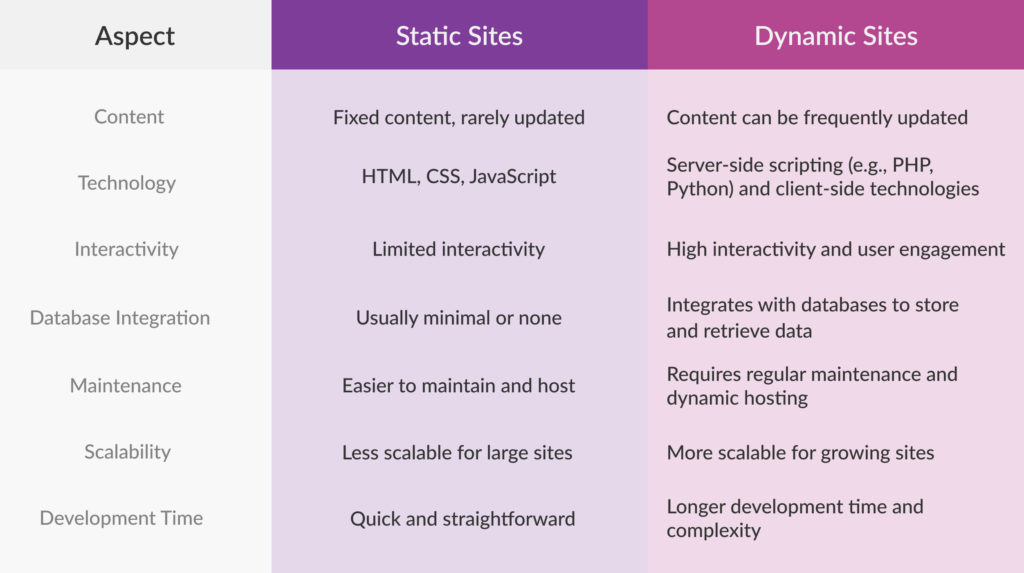Imagine two types of websites: one acts like a static poster, staying the same unless manually changed, while the other behaves like a bustling bookstore, constantly updating its shelves. Static websites are simple and quick to load, but they lack interactive features.
On the flip side, dynamic websites use databases to offer personalized experiences and real-time updates, making them more versatile and engaging. Understanding these differences can help you decide which type suits your online needs.

What is a Static Website?
A static website development is like a digital brochure. It’s composed of fixed web pages with content that remains unchanged until manually updated. Think of it as a poster on the internet – it displays information, text, images, and links but doesn’t adapt or interact with users. Static websites are easy to create, load quickly, and are suitable for showcasing information that doesn’t need frequent changes, like company profiles, event details, services, or product pages. However, they lack features for user interaction and dynamic content updates.
Advantages of Static Website
-
Speed and Performance
Static websites load quickly because they consist of pre-built HTML files. There’s no need for server-side processing or database queries, resulting in almost instant page loading. This is crucial for providing a seamless user experience, especially on slower internet connections.
-
Security
Static websites are inherently more secure. With no backend or database to exploit, they are less susceptible to hacking attempts. This simplicity in architecture reduces the attack surface and the chances of security vulnerabilities.
-
Reliability
Static sites are highly reliable because they lack complex server-side processes that can fail. They are less prone to crashes, downtime, or performance issues, ensuring consistent visitor access.
-
Hosting Flexibility
Static sites can be hosted on a wide range of servers, including inexpensive options. This versatility in hosting solutions makes them cost-effective to set up and maintain.
-
Content Security
Since updates to a static website involve directly modifying HTML or other files, unauthorized changes are less likely. This assures the integrity of your content.
-
Offline Access
Users can access a static website’s content even without an internet connection. This can be beneficial in conditions where internet access is limited or unreliable.
Disadvantages of Static Website
-
Limited Interactivity
Static websites are not designed for interactive features like user logins, comments, or real-time updates. They provide a one-way flow of information, limiting user engagement.
-
Limited User Engagement
Due to their static nature, these websites offer a passive user experience. Users cannot contribute content or interact with the site beyond navigating predefined pages.
-
Search Functionality
Implementing advanced search functionality on static websites can be challenging. They may need help to provide robust and flexible search results compared to dynamic websites with databases.
-
E-commerce Limitations
Building complex e-commerce functionalities, such as shopping carts, product catalogs, or real-time inventory updates, can be difficult on static sites. This makes them less suitable for businesses that require sophisticated online stores.
What is a Dynamic Website?
A dynamic website is like a virtual space that constantly changes and adapts. It’s a digital platform that utilizes databases and scripting languages to generate content in real-time. Imagine it as a bustling marketplace where information is updated dynamically based on user interactions or data inputs.
Unlike static websites, dynamic sites can personalize content for each visitor, facilitate online transactions, support user logins, and offer interactive features like comments or forms. They’re highly flexible, enabling businesses to provide a rich, customized experience to users while seamlessly managing a wide array of content and functionalities.
Advantages of Dynamic Website
Dynamic websites offer numerous advantages and disadvantages compared to static websites.
-
Real-Time Updates
Dynamic websites allow for real-time updates, enabling content to be instantly changed or added without requiring extensive technical knowledge. This is ideal for businesses and organizations that need to frequently update their information, such as news websites, blogs, or event listings.
-
Content Management Systems (CMS)
Dynamic websites often use content management systems like WordPress or Drupal, which provide user-friendly interfaces for managing content. These systems make it easy for non-technical users to add, edit, and organize content, reducing the reliance on web developers.
-
Search Functionality
Dynamic websites can incorporate robust search functionality, making it easier for users to find specific information within the site. This is crucial for websites with large amounts of content or complex navigation structures.
-
E-commerce Capabilities
Dynamic websites are well-suited for e-commerce, as they can handle the complexities of online shopping, including product catalogs, shopping carts, and secure payment processing.
-
Scalability
Dynamic websites can scale with the growth of a business or organization. Adding new pages, features, or functionalities can be relatively straightforward compared to static websites.
-
Integration with APIs
Dynamic websites can integrate with third-party APIs, enabling them to pull in data from external sources, such as social media feeds, weather updates, or payment gateways. This enhances the website’s functionality and user experience.
Disadvantages of Dynamic Website
-
Complex Development
Creating dynamic websites is more complex and time-consuming than static ones, as they require server-side scripting and database integration. This complexity can direct to longer development periods.
-
Higher Development Costs
Due to the complexity and expertise required, dynamic websites tend to be more expensive to develop and maintain than static sites. Businesses must budget for ongoing costs, including hosting, security, and updates.
-
Maintenance Overhead
Dynamic websites require regular maintenance, including software updates, security patches, and database optimization. Neglecting maintenance can lead to performance issues and security vulnerabilities.
-
Security Risks
Dynamic websites are more susceptible to security risks, such as SQL injection attacks and cross-site scripting (XSS), due to their interactive nature and reliance on databases. Robust security standards are critical to protect against these threats.
-
Slower Load Times
Dynamic websites can load more slowly than static ones because they generate content on the fly, which can increase server response times. Optimizing dynamic sites for speed is crucial to maintaining a positive user experience.
-
Compatibility Issues
Dynamic websites may face compatibility issues across browsers and devices, requiring extra effort to ensure a consistent user experience. Testing and cross-browser compatibility checks are essential to address this challenge.
Conclusion
To sum it up, dynamic websites epitomize adaptability in the online sphere, providing real-time, personalized experiences and a gateway to a diverse range of functionalities. However, this dynamic nature demands careful consideration of potential complexities in development, higher budget allocation, ongoing upkeep, security fortification, occasional trade-offs in speed, and the need for compatibility checks. Navigating these aspects thoughtfully allows for harnessing the true potential of a dynamic website, tailoring its advantages to suit the specific needs and aspirations of the digital venture.

